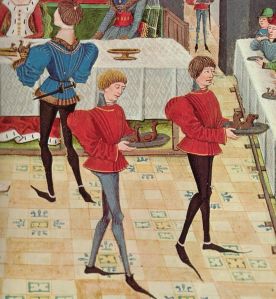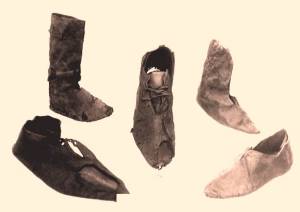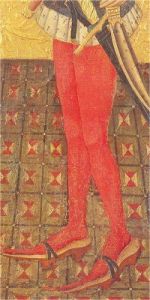Originally posted by Allison D. Reid:
Early in the period, footwear was still influenced by the Romans and nomadic European tribes that came before. They were largely stiff, poor quality, stitched leather wraps with laces to hold them to the ankle—not much better than walking barefoot. In colder regions these might have been lined with fur for warmth. As the Middle Ages progressed, and trade increased, higher quality leather became available, and the crusades exposed Europe to Byzantine styles. Shoe and boot makers might be called cordwainers (12th century on) or chaucers, and as was the case with most other medieval trades, they were regulated by guilds. Cobblers, however, did not make brand new footwear. They were only permitted to repair shoes that had been made by someone else.
 The types of shoes worn would be different depending on your trade, where you lived, and your social status. They might be made of leather, wool, fur, or wood. Peasants often wore poor quality knee-high boots that laced up the front. English peasants also wore a heavy shoe made of undressed leather with the hair on the outside. They were called revelins or slops. The nobility wore a high quality close-toed slipper, the design of which changed with the fashions of the day. Early on, they remained relatively plain, but in the high and late Middle Ages they may have been elongated, pointed, and/or decorated with elaborate designs. Leather shoes could be stamped, tooled, or decorated with cutouts. Shoes were not always necessary, however. As hose became fashionable for men, soles were often sewn directly into the hose.
The types of shoes worn would be different depending on your trade, where you lived, and your social status. They might be made of leather, wool, fur, or wood. Peasants often wore poor quality knee-high boots that laced up the front. English peasants also wore a heavy shoe made of undressed leather with the hair on the outside. They were called revelins or slops. The nobility wore a high quality close-toed slipper, the design of which changed with the fashions of the day. Early on, they remained relatively plain, but in the high and late Middle Ages they may have been elongated, pointed, and/or decorated with elaborate designs. Leather shoes could be stamped, tooled, or decorated with cutouts. Shoes were not always necessary, however. As hose became fashionable for men, soles were often sewn directly into the hose. Turnshoes were the most popular type of medieval shoe, particularly in the northern regions. These ankle-high shoes had a triangular flap that folded over the ankle and stayed attached with a latchet or thongs. They were very plain, with no embellishments and flat soles. These types of shoes were made inside out, then soaked in a bucket of water until they were soft enough to turn them the right way. This would have been done very carefully to prevent over-stretching the leather or tearing it. Once completely dry, the shoe would be stiff again. It might have a sole added at this stage, but it could also be worn without one.
Turnshoes were the most popular type of medieval shoe, particularly in the northern regions. These ankle-high shoes had a triangular flap that folded over the ankle and stayed attached with a latchet or thongs. They were very plain, with no embellishments and flat soles. These types of shoes were made inside out, then soaked in a bucket of water until they were soft enough to turn them the right way. This would have been done very carefully to prevent over-stretching the leather or tearing it. Once completely dry, the shoe would be stiff again. It might have a sole added at this stage, but it could also be worn without one. In the 14th century, clogs or pattens also became common. They were an overshoe that offered protection from wet and muddy streets. The bottoms were made of wood or cork, with a leather strap to hold them to the foot. Some had a hinged heel to make walking easier. Techniques that allowed a heavier sole to be attached to a regular shoe were not developed until the 15th century. Stacked heels did not come about until after the Renaissance period.
In the 14th century, clogs or pattens also became common. They were an overshoe that offered protection from wet and muddy streets. The bottoms were made of wood or cork, with a leather strap to hold them to the foot. Some had a hinged heel to make walking easier. Techniques that allowed a heavier sole to be attached to a regular shoe were not developed until the 15th century. Stacked heels did not come about until after the Renaissance period.While some shoes were tailored specifically to the wearer’s feet, ready-made shoes in several different sizes were also available as the trade began to boom. There was little to no distinction between a right and left shoe such as there is today. Shoes might have been padded for comfort, or to correct the fit as the material stretched with wear. Padding would have been made from materials like wool, fur, hair, or moss.
One of the most interesting aspects of this topic is that medieval shoes required a different style of walking than we are accustomed to today. To comfortably wear a medieval style shoe, one would need to point their feet forward, rather than at an angle, take a shorter stride, and land on the front of the foot rather than the heel. Roland Warzecha, who teaches historical European combat fighting, made a video explaining the body mechanics of how medieval people walked. It is less than 7 minutes long, but very informative!
Want to know more about the Middle Ages? Check out the Medieval Monday Index for additional topics.



No comments:
Post a Comment